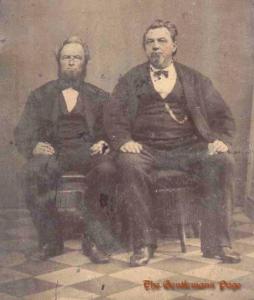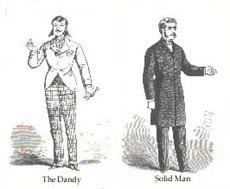Victorian Gentleman's Attire
What a Victorian gentleman ought to wear.
 "Any man may be in good spirits and good temper when he's well dressed. There ain't much credit in that."
"Any man may be in good spirits and good temper when he's well dressed. There ain't much credit in that."
"Dignity, and even holiness too, sometimes, are more questions of coat and waistcoat than some people imagine."
"Great men are seldom over-scrupulous in the arrangement of their attire. "
Charles Dickens
"A well dressed man does not require so much an extensive as a varied wardrobe. He wants a different costume for every season and every occasion; but if what he selects is simple rather than striking, he may appear in the same clothes as often as he likes, as long as they are fresh and appropriate to the season and the object.
There are four kinds of coats which he must have: a business coat, a frock coat, a dress-coat and an overcoat. A well dressed man may do well with four of the first, and one each of the others per annum. An economical man may get by with less."
"The dress of a gentleman should be such as not to excite any special observation, unless it be for neatness and propriety. The utmost care should be exercised to avoid even the appearance of desiring to attract attention by the peculiar formation of any article of attire, or by the display of an immoderate quantity of jewelry, both being a positive evidence of vulgarity. His dress should be studiously neat, leaving no other impression than that of a well dressed gentleman."
Martine's Handbook of Etiquette, 1866
"Don't dress like a 'dude' or a 'swell'; nor carry a little poodle dog (a man's glory is his strength and manliness--not in aping silly girls), nor cock your hat on one side, nor tip it back on your head (let it sit straight and square), nor wear anything conspicuous or that will make you offensive to others"
Modern Manners and Social Forms, 1889
"The native independence of American character regards with disdain many of the stringent social laws which are recognized in England and on the continent. Thus, the dress which many of our countrymen adopt...would subject them to serious annoyance abroad."
"Martine's Handbook" 1866

"It was at one time the fashion to affect a certain negligence, which was called poetic, and supposed to be the result of genius. An ill-tied, if not positively untied cravat was a sure sign of an unbridled imagination; and a waistcoat was held together by one button only, as if the swelling soul in the wearer's bosom had burst all the rest. If in addition to this the hair was unbrushed and curly, you were certain of passing for a "man of soul". I should not recommend any young gentleman to adopt this style, unless he can mouth a great deal, and has a good stock of quotations of the poets. It is of no use to show me the clouds, unless I can see you in them, and no amount of negligence in your dress and person will convince me you are a genius, unless you can produce an octavo volume of poems published by yourself"
The Habits of Good Society, 1859
This last quote is an attack on the fashion of the late 1850s and 1860s for men to look like they slept in their rumpled clothes, with sloppy unsymmetrical ties, greasy stringy hair, and some number of vest buttons invariably undone. This general sloppiness can be seen in thousands of Civil War era images.
